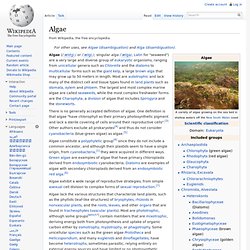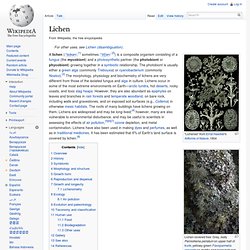

Algae. The lineage of algae according to Thomas Cavalier-Smith.

The exact number and placement of endosymbiotic events is currently unknown, so this diagram can be taken only as a general guide[1][2] It represents the most parsimonious way of explaining the three types of endosymbiotic origins of plastids. These types include the endosymbiotic events of cyanobacteria, red algae and green algae, leading to the hypothesis of the supergroups Archaeplastida, Chromalveolata and Cabozoa respectively. However, the monophyly of Cabozoa has been refuted and the monophylies of Archaeplastida and Chromalveolata are currently strongly challenged. [citation needed] Endosymbiotic events are noted by dotted lines. Seaweed. Seaweed is a macroscopic, multicellular, benthic marine algae.[1] The term includes some members of the red, brown and green algae.

Seaweeds can also be classified by use (as food, medicine, fertilizer, filtration, industrial, etc.). Taxonomy[edit] A seaweed may belong to one of several groups of multicellular algae: the red algae, green algae, and brown algae. As these three groups are not thought to have a common multicellular ancestor, the seaweeds are a polyphyletic group. In addition, some tuft-forming bluegreen algae (Cyanobacteria) are sometimes considered to be seaweeds — "seaweed" is a colloquial term and lacks a formal definition. Lichen. A lichen (/ˈlaɪkən/,[1] sometimes /ˈlɪtʃən/ [2]) is a composite organism consisting of a fungus (the mycobiont) and a photosynthetic partner (the photobiont or phycobiont) growing together in a symbiotic relationship.

The photobiont is usually either a green alga (commonly Trebouxia) or cyanobacterium (commonly Nostoc).[3] The morphology, physiology and biochemistry of lichens are very different from those of the isolated fungus and alga in culture. Lichens occur in some of the most extreme environments on Earth—arctic tundra, hot deserts, rocky coasts, and toxic slag heaps. However, they are also abundant as epiphytes on leaves and branches in rain forests and temperate woodland, on bare rock, including walls and gravestones, and on exposed soil surfaces (e.g., Collema) in otherwise mesic habitats. The roofs of many buildings have lichens growing on them.